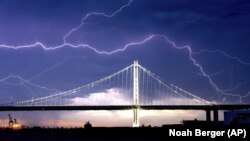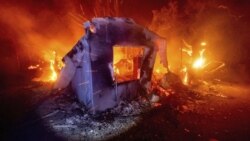The lightning began in the skies over Northern and Central California one weekend in mid-August. It landed on grassy areas and vineyards.
The U.S. National Weather Service warned that the dry lightning hitting dry land “could lead to new wildfire.”
It turned out to be a much bigger problem than expected.
Thousands of lightning bolts caused hundreds of fires in California and at least one in Oregon. They led to some of the most destructive wildfires that the West Coast has seen in modern times.
One month later, firefighters are still battling them. At least 35 people have died in California, Oregon and Washington.
The wildfires have taken away people’s “sense of security,” said Oregon Department of Forestry spokesman Jim Gersbach. “These (fires) burned so close to populated areas, driven by this wind — basically unstoppable,” he added.
The huge wildfires started a debate over whether climate change or a lack of good forest management was the bigger problem this time. Several studies have found that a warming planet increases the chances of extreme events – and increases their severity. But many experts have also argued that thinning forests and reducing the amount of dead leaves and other dry plant materials will give fire less fuel.
Before the series of lightning strikes, the West Coast’s fire season had been a little more severe than normal. In Oregon, officials had decided not to let the fires grow. They ordered even small fires to be covered quickly by aircraft. That way, large groups of firefighters would not be needed. The plan was meant to prevent the spread of the coronavirus, Gersbach told The Associated Press.
But then came the weekend of August 15 and 16.
The National Weather Service reported that it had been an “insane 12 hours across the Bay Area” of San Francisco. During that period, lightning struck all around San Francisco’s famous Bay Bridge.
But that was just the first part of it.
The second part came three weeks later, when another strange weather event happened.
A very large high-pressure area developed all the way from Alaska to the desert in the Southwest. It brought summer snow to places like Denver, Colorado. It also pushed warm, dry wind toward the Pacific coast, said Greg Jones. He is a professor and climate science researcher at Linfield University in McMinnville, Oregon. Normally, the winds in early September go in the opposite direction, he noted.
Those strong winds pushed the fires through trees and brush that had been drying out all summer. The winds caused the fires to explode in size. The fires quickly moved into towns and rural homes. Many locals could only flee with the clothes on their backs.
Jones called the weather conditions “likely a once in a generation event.”
For the first time ever, five so-called megafires were burning at the same time in Oregon. A megafire is one that covers at least 405 square kilometers.
Smoke covered the West Coast states, creating some of the most dangerous air quality in the world. Seattle’s famous Space Needle building was mostly hidden by brown air particles. The smoke reached all the way across the United States and even into parts of Europe.
Large groups of firefighters arrived, walking through blackened lands toward the flames. National Guard troops joined the effort. Even local residents tried to save homes by breaking firelines by hand and using digging and clearing trucks.
Local resident Kerry Kuenzi got together with several other people to fight a huge fire in Scotts Mills, Oregon. He told The Oregonian newspaper that people have to come together in times like these because “it’s like a war” out there.
The Beachie Creek Fire he fought covered less than two square kilometers on September 7. But high winds and extremely dry plant material on the ground made the fire grow quickly. By the next day, it had spread across 530 square kilometers, fire officials said.
New fires continued to start in California and Oregon. Burned lands and destroyed remains of mobile homes and other buildings could be seen everywhere.
The flames were so intense that firefighters sometimes had to stop their work. “You cannot really stand there with a hose” when you have 48 kilometer-an-hour winds and dry fuels, Gersbach said.
Firefighters from across the U.S. and Canada have hurried to the area to help fight the blazes. As of September 22, there were close to 19,000 firefighters in California fighting more than 27 major wildfires. Also as of September 22, close to 8,500 firefighters were fighting 23 large wildfires in Oregon and Washington.
The California Department of Forestry and Fire Protection says that more than 1.2 million hectares have burned this year in the state — more than ever before. In Oregon, about 400,000 hectares have burned since the start of this year.
Residents are hoping for rain to wash away the wildfire smoke. In Oregon, rains over much of the state late last week helped battle wildfires but did not put them out. Northern California remains dry though calming winds and lower temperatures — caused in part by the smoke blocking the sun — have helped firefighters. Small amounts of rain are predicted for far northern California and the Sierra Nevada mountains.
I’m Jonathan Evans.
And I’m Alice Bryant.
Andrew Selsky wrote this story for The Associated Press. Alice Bryant adapted it for Learning English. Ashley Thompson was the editor.
_______________________________________________________
Words in This Story
vineyard - n. a field where grapes are grown
bolt - n. a bright line of light that appears in the sky during a storm
management - n. the act or skill of controlling and making decisions about a business, department or something else
Bay Area - n. an area in Northern California including the city of San Francisco and surrounding counties
brush - n. wood from small branches on a tree
flame - n. a state of burning brightly
resident - n. someone who lives in a particular place
mobile - adj. able to be moved
hose – n. a long, usually rubber tube that liquids or gases can flow through










